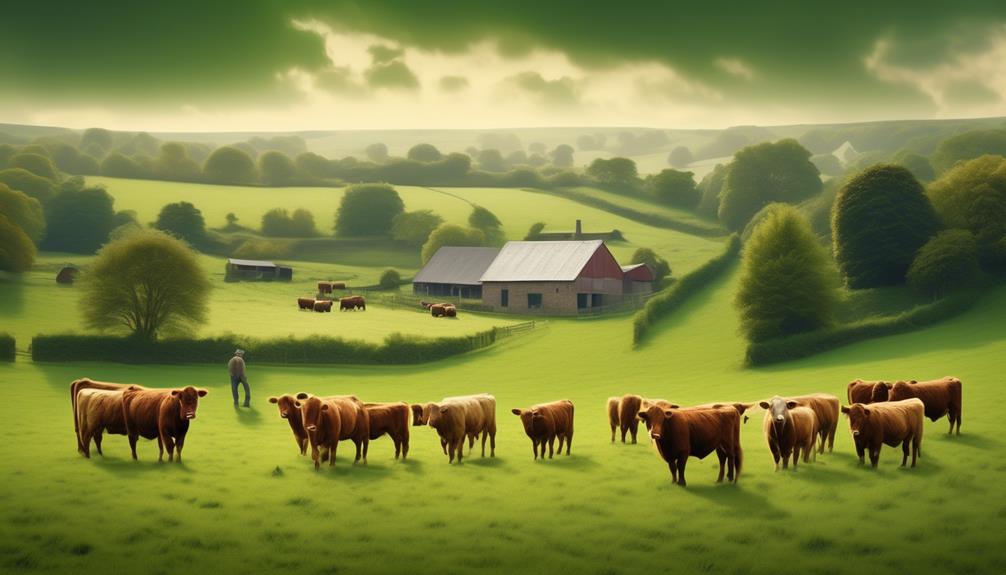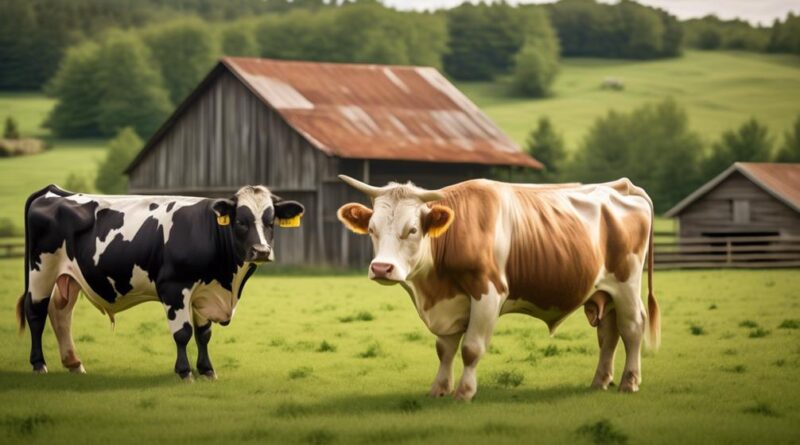Top 10 Low Maintenance Cattle Breeds for Small Farms
Imagine if you could cultivate a low-maintenance, fruitful garden that requires minimal tending and yields bountiful results. Well, in the world of cattle farming, there are breeds that can offer a similar experience.
From the hardy and resilient Dexter to the robust and adaptable Hereford, there are several low-maintenance cattle breeds that are perfectly suited for small farms. But which ones are the top 10?
Stick around to discover the ideal bovine companions for your small-scale farming venture.
Dexter
Looking for a low-maintenance cattle breed for your small farm? Consider Dexter cattle, known for their adaptability and efficiency in limited space. Dexters are a highly efficient breed, making them ideal for small farms. Their dual-purpose nature, providing both meat and milk, makes them a valuable addition to any small-scale farming operation.
Their compact size, with cows typically standing at around 40 inches tall and weighing between 600 to 800 pounds, makes them well-suited for limited grazing areas.
Dexters are renowned for their ability to thrive on modest amounts of forage, which can be particularly advantageous for small farms with limited pasture space. Their smaller stature means they require less feed overall, contributing to their reputation as a low-maintenance breed. Additionally, their dual-purpose capabilities mean that a single Dexter cow can provide both milk for the household and, eventually, meat for the table, making them a practical choice for small-scale, self-sustaining farms.
In terms of temperament, Dexters are known for their docile nature, making them easier to handle for small farmers. Their gentle disposition also makes them suitable for smaller farm setups where close interaction with humans is common.
Hereford
Adaptable and hardy, the Hereford breed is well-suited for small farms due to its low-maintenance nature and efficient use of grazing resources. Hereford cattle are known for their distinctive red and white coat, docile temperament, and excellent foraging abilities. These characteristics make them ideal for small farms with limited resources and space.
Hereford cattle are also known for their high fertility rates, ease of calving, and good mothering instincts, which further reduces the need for intensive management.
When it comes to Hereford cattle breeding practices, the breed is renowned for its ability to thrive in various environmental conditions. Herefords are adaptable to different climates, making them suitable for small farms in diverse geographical locations. Their natural hardiness reduces the need for extensive shelter and special care, making them a low-maintenance option for small farmers.
Additionally, Hereford cattle have a relatively low feed intake compared to other breeds, allowing small farm owners to save on feeding costs while still maintaining healthy and robust livestock.
Belted Galloway
The Belted Galloway breed, with its distinctive black and white coat, is a low-maintenance option for small farms due to its hardy nature and efficient use of grazing resources. If you're considering raising Belted Galloways on your farm, here's what you need to know:
- Grazing Benefits
- Belted Galloways are exceptional grazers, known for their ability to thrive on rough forage and marginal pastures. Their efficient conversion of grass into high-quality beef makes them a cost-effective choice for small farms. Their grazing habits also help maintain pasture health and reduce the need for supplemental feeding, making them ideal for sustainable farming practices.
- Heritage Breed Conservation Efforts
- By raising Belted Galloways, you contribute to the conservation of this heritage breed. With a rich history and unique appearance, these cattle are valued not only for their productivity but also for their cultural significance. Supporting and breeding Belted Galloways helps preserve genetic diversity within the cattle industry and ensures the continuation of a breed that has adapted to various environmental conditions over centuries.
Highland
If you're considering introducing a hardy and low-maintenance breed to your small farm, the Highland cattle may be an excellent choice. Highland cattle are renowned for their climate adaptability, making them ideal for small farms in various regions. Their shaggy coats provide insulation in harsh weather conditions, allowing them to thrive in cold and mountainous areas where other breeds may struggle. This adaptability reduces the need for extensive shelter and extra care, making them a cost-effective option for small-scale farmers.
Highland cattle are also well-suited for conservation grazing. Their grazing habits help maintain diverse ecosystems by promoting the growth of various plant species. Their ability to thrive on rough forage and in challenging terrains makes them valuable for land conservation and restoration efforts. By introducing Highland cattle to your farm, you can actively contribute to environmental preservation while maintaining a sustainable and low-maintenance cattle herd.
In addition to their hardiness and adaptability, Highland cattle are known for their low input requirements. They efficiently convert forage into high-quality meat, making them a practical choice for small farms with limited resources. Their self-sufficiency and ability to thrive on natural vegetation further reduce the need for supplemental feeding and intensive management.
Red Poll
Considering your small farm's need for a resilient and low-maintenance breed, the Red Poll cattle presents itself as a promising option. This dual-purpose breed is known for its adaptability to various climates and its ease of management, making it an ideal choice for small-scale farmers.
- Breeding Characteristics
- Red Poll cattle are renowned for their docile temperament, making them easier to handle, especially for novice farmers or those with limited resources for handling equipment. Their calm nature also makes them less prone to stress-related health issues, reducing the need for intensive monitoring and care.
- These cattle are known for their high fertility rates and strong maternal instincts, which can be advantageous for small farms looking to expand their herd through natural breeding practices. The breed's ability to calve without assistance further contributes to their low-maintenance appeal, minimizing the need for veterinary interventions during calving season.
Optimal Feeding Practices
- Red Poll cattle are efficient foragers and have a moderate appetite, thriving on pasture-based diets. Their ability to efficiently convert forage into high-quality meat and milk makes them a cost-effective option for small farms with limited access to concentrated feeds.
- While they're well-suited to grazing, supplementing their diet with good-quality hay during the winter months ensures year-round nutritional balance, supporting their overall health and productivity.
Incorporating Red Poll cattle into your small farm can offer a low-maintenance yet productive cattle option, with their favorable breeding characteristics and efficient feeding practices aligning well with the needs of small-scale operations.
Longhorn
A resilient and iconic breed for small farms, Longhorn cattle offer a combination of hardiness and adaptability that can benefit your farming operation. Longhorns are renowned for their low-maintenance nature, making them an excellent choice for farmers looking for a breed that can thrive with minimal intervention.
These cattle are well-suited to a range of climates and terrains, and their ability to forage and graze extensively reduces the need for supplemental feeding, which can be a significant cost-saving advantage for small farms.
When considering breeding characteristics, Longhorns stand out for their natural resistance to many common cattle diseases and parasites. This inherent resistance means less reliance on veterinary interventions and medications, aligning with the low-maintenance requirements of small farms. Longhorns are also known for their high fertility rates and ease of calving, further reducing the need for intensive reproductive management.
In terms of meat quality characteristics, Longhorn beef is prized for its leanness and distinct flavor. Despite their leaner frame, Longhorns yield flavorful and tender meat, making them a valuable choice for small-scale meat production operations. Additionally, their efficient conversion of forage into lean meat contributes to cost-effective and sustainable beef production.
Sussex

Sussex, another low-maintenance cattle breed ideal for small farms, offers a robust and adaptable option to complement the hardiness and versatility of the Longhorn. If you're considering adding Sussex cattle to your farm, here are some key points to consider:
- Breeding Characteristics
- Sussex cattle are known for their excellent maternal instincts, making them great mothers for calving and raising calves without much human intervention. This is a valuable trait for small farms where close monitoring of every animal may not be feasible.
- They've a high fertility rate, which means they can reproduce reliably without needing extensive veterinary assistance. This is advantageous for small farms with limited resources for reproductive technologies and interventions.
- Health and Disease Management
- Sussex cattle are naturally resistant to many common cattle diseases, reducing the need for extensive medical treatments and vaccinations. This makes them a cost-effective option for small farms with limited budgets for veterinary care.
- Their hardy nature and ability to thrive in various climates also contribute to their overall resilience to environmental stressors, further minimizing the need for constant health management.
Salers
Salers cattle breed offers a resilient and adaptable option for small farms, known for their hardiness and efficient foraging abilities. Their breeding characteristics make them highly suitable for low-maintenance farming. Salers are naturally polled and have a strong maternal instinct, making them excellent mothers with high reproduction rates. This means less intervention is needed during calving, reducing the workload for small farm owners.
In terms of nutritional requirements, Salers are efficient converters of forage and have a moderate feed intake, which is beneficial for small farms with limited resources. They thrive on grass and hay, requiring minimal supplementation, which makes them an economical choice for farmers looking to minimize feeding costs.
Disease resistance is another standout feature of the Salers breed. They've a robust immune system and are less susceptible to common cattle ailments, reducing the need for extensive veterinary care and medications. This resilience contributes to their low maintenance requirements, making them an attractive option for small farms with limited resources.
When it comes to reproduction rates, Salers are known for their high fertility and ease of breeding. This means that small farm owners can efficiently grow their herd without extensive reproductive interventions.
Frequently Asked Questions
What Are the Average Milk Production Levels for Each of These Cattle Breeds?
To determine milk production levels for each breed, consider their dietary requirements and genetic health. Assess climate adaptability as well. Research individual breeds for more specific data on average milk production levels.
Are There Any Specific Health Concerns or Diseases That These Breeds Are More Susceptible To?
You should be aware of genetic predispositions and susceptibility to specific diseases in low-maintenance cattle breeds. Overall health concerns can be influenced by breeding practices, environmental factors, and disease prevention strategies.
Can These Cattle Breeds Adapt Well to Different Climates and Environments?
Can these cattle breeds adapt well to different climates and environments? Yes, they exhibit strong adaptability to diverse climates, making them suitable for various small farm settings. Their resilience supports sustainable environmental impact and farming practices.
What Are the Average Lifespan and Reproductive Capabilities of These Cattle Breeds?
The average lifespan of these cattle breeds varies, but they generally live 15-20 years. Their reproductive efficiency is high, and genetic diversity supports longevity. With proper herd management, they can contribute to sustainable small-scale farming.
Are There Any Specific Management Practices or Feeding Requirements That Are Unique to These Breeds?
When raising low maintenance cattle breeds, it's important to consider their unique feeding requirements and grazing management. These breeds are known for their reproductive capabilities and climate adaptation, making them suitable for small farms.
Conclusion
So there you have it, the top 10 low maintenance cattle breeds for small farms. Whether you're a beginner or just looking for an easy-to-care-for breed, these options are sure to fit the bill.
With their hardy nature and minimal upkeep requirements, you can focus on other aspects of your farm and still have healthy, thriving cattle. Consider adding one of these low maintenance breeds to your farm and enjoy the benefits of their easy care.
